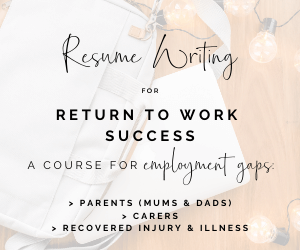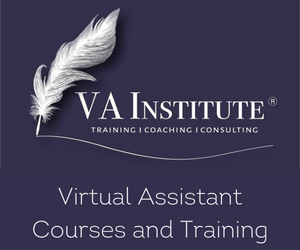Whether you’re looking to kick start your career full steam ahead or find a less demanding role, your resume is the all-powerful document that gets you that initial meeting. The first trick is to get past the skim read, so that recruiters will take a second, more in depth look at your resume.
After some time out of the workforce it can be very daunting for mums (or dads) to start applying for work again. If you’ve taken time off to be a stay at home parent there is usually a gap that needs to be explained and you may feel that your skills and experience are not up to date. However, there are things that will give you confidence in applying for positions.
- Own the gap. You were doing a great thing raising your children, don’t shy away from that.
- Show relevance. Make sure you showcase any skills, experience or education that would be relevant for the job you’re applying for.
- Use transferable skills. If your choosing a different field to work in after children, that doesn’t mean the skills you had in your previous career don’t count. Show how your skills can be used in the new position.
- Keep things current. Unless you’ve had a huge gap at home with the kids make sure you are highlighting the last 10 years. Employers aren’t concerned about whether you learnt the flute in high school.
- Show achievements. Employers want to see what you achieved in your previous roles, not just what you were responsible for.
- Be honest. If you lie to secure a job it can be easily found out these days.
Yes, there may be employers out there who will refuse you the job because you’re a mum, but those are the places you really wouldn’t want to work at, anyway. You’re not just looking for a job; you’re looking for the right job, and a great resume is the first step to having the confidence to go for the jobs you really want. If you need extra guidance, the Resume Writing for Return to Work Success Program is a great start.
Tips for Your Resume When You’re a Return to Work Mum
Here are some key resume tips for mums to help get your resume noticed and feel confident!
Put it in a format people can read
Make sure when you send your resume through to someone, you know they’ll be able to open it and read it with the correct formatting you intended. The best way to do this is by sending as a word document or saving it as a PDF which can be done easily in Word and other programs. This also allows some recruiting programs to scan your resume easily.
Make sure your details are correct
Your name, phone number and address need to be easily found and correct so that you can be contacted. You don’t want to put all that effort into having the perfect resume to find out that the employer can get hold of you for an interview. Don’t worry about putting your date of birth on there, it’s not important information.
Make sure you have a professional sounding email address. Ideally use something like your.name@gmail.com rather than sexybutterfly@gmail.com. Having a professional sounding email won’t get you the job but having a nonprofessional email address may cost you an interview.
Don’t hide your employment gap
It might feel like a long time since you’ve been in the workplace, but in reality it’s a comparatively short time. Some people take longer vacations just to go overseas! You weren’t just sitting around on the couch watching Netflix (or if you were don’t tell them that) you were raising small humans!
Becoming a mother means that you develop all sorts of new skills, and they aren’t all related to child care. Don’t ignore your own personal development during your maternity leave. Perhaps you’ve improved your time management skills or your ability to multi-task. These are skills which are directly transferable to the workplace. Take a close look at the job requirements and selection criteria and identify the matches with your new skillset.
Employment history
Provide dates, the title of your role, the company you worked for and any achievements you made while in that position. Make sure your most recent positions are first and work back from there.
Avoid getting dates wrong or not including them
A CV that does not include dates sends out ‘red flags’ about a candidate’s background and is immediately disregarded. The obvious assumption is that the candidate is trying to hide something. Furthermore, be honest about your dates of employment.
When providing dates, work history should be in reverse chronological order (start with the most recent job). The general consensus among recruiters is to place the employer info, title and location to the left-hand side of the screen. Your employment dates should be aligned to the right so that your reader can easily ‘skim’ down the page. If you have a proven track record of staying in a job for a while, absolutely make sure that your employment dates JUMP out at your reader. This is a real selling point about you as a candidate.
Achievements, not duties
Achievements are the meat of your resume, not responsibilities. Do not submit a position description – submit a document that sells your value-add. What did you achieve at your last jobs? Don’t just rehash what you did there.
Taking time off work doesn’t negate any of your special achievements. If you’ve won an award, it’s because you deserved it. If you brought a project home under budget, you’ve done a remarkable job. If you’ve led the most productive team in your organisation, you have the runs on the board. These are still outstanding results whether they occurred this year or last. Make sure you feature them.

Keep it short and stay clear
Nobody is going to read a 5 page resume. In most situations make sure you keep your resume to a maximum of 2 pages. Put the most important skills and experience that match the job you are applying for. If the employer wants to know more, they will contact you and give you a chance to expand further.
One way to keep it brief is by using bullet points to address the key selection criteria. Remember, the aim is to spark the recruiter’s interest to open your CV. As tempting as it may be to outline every single job you’ve ever worked in, try to spare recruiters the details. You only need to detail the past five-to-eight years of employment. You should provide a brief summary under ‘Previous Employment’ for anything that dates earlier (your job title, company and dates).
Ensure you use laser focused statements, do not waffle. The KISS principal really does apply (Keep It Simple Stupid) – you can always expand on anything in a phone interview.
Be relevant
Relevance is key! Read through the key selection criteria and cull, cull, cull. The employer wants to know about your achievements, awards, and successes in your career. What they do not want to know is about the black belt you got in Karate (unless you’re applying to a Karate school) or the certificate you got when you won the spelling bee in school.
If you have a degree from University, then don’t worry about putting your high school on there. Any further education such as diplomas or degrees will eclipse anything you did in school.
Skills are transferable
Are you a mum returning to work but in a different field to your previous career? Talk up your transferable skill set and adaptability. Your fresh perspective might just be what the employer is looking for.
Be yourself
Speak to your brand – it’s your asset. You are a mum, career woman, teacher, wife – what makes you, YOU? Skills, personality, values all come into play here.
Toss out the Career Objective
Have a Career Summary or Performance Summary instead. If you read it and it can apply to anyone, you are not being specific enough. It must be unique to you. Begin with a summary of achievements and qualifications that showcase your skills that are the most relevant to the position you’re seeking.
Being a return to work mum it is particularly important to outline your motivations as employers may question why you are looking to change industries or applying for positions that ‘downgrade’ from what you used to do.
Stay away from clichés
Avoid overused phrases like ‘proven ability to deliver results’ or ‘accomplished professional’ – detail your results, professional in what specific area?
Avoid the most overused words on LinkedIn such as responsible, strategic, effective, analytical to name a few. Employers want quantified examples not generic fluff.
Keep it current
Keep your resume to no more than 10 years; remember employers do not want your life story. You need to update your resume to feature present information, not information way in the past, as it will do nothing to show the interviewer why they should hire you.
Consider upskilling
Has your industry changed since you were last working? Is there something that you could learn that would put you ahead of the competition? If it’s been a while since you’ve been involved, you may want to consider doing a course or upgrading your skills. This doesn’t have to be a major thing, even a short course hones your skills ready for employment and shows employers that you are taking a real interest in your industry. For example, if you are a marketer, doing a quick course in Facebook advertising shows that you are still keeping up with today’s changing marketing world.
This is even more important if you are wanting to change from the type of job you were doing before you had children or are changing industries entirely. Looking at sites like Udemy gives an idea of the sorts of short courses that are available.

Be honest
Don’t Lie. If you lie to secure a job, you will get caught before you even step into the interview room. These days, interviewers can quickly check if you are lying or not about yourself and your achievements by conducting a quick Google search online.
Here are some of the most common examples of misleading information being put in CVs:
– Inflated titles and embellished duties
– Inaccurate dates to cover up job hopping or gaps of employment
– 1/2 finished degrees, inflated education, or ‘purchased’ degrees that do not mean anything
– Inflated salaries
– Exaggerated accomplishments
– Out and out lies in regards to specific roles and duties
Make sure you format correctly
Look at your formatting – mix it up, use dot points, and make it scannable. CRABS – Chunkability, Relevance, Accurate, Brevity, make sure it is clearly Scannable. Above all, make sure you proofread and edit. There is nothing worse then saying how great you are at details and having your resume full of spelling mistakes.
Carefully check for spelling errors, typos, and poor grammar.
In the world of technology and ‘Spell Check’, you would be amazed how many CVs come through with errors!
Your CV provides a first impression of who you are. First and foremost, always do a spell check using the ‘review’ tab in your Word program. Next, find a trusty pal to proof read it if necessary. Also check for consistency in your use of past/present tense and formatting.
Read the job advertisement
It is common to just skim the advertisement looking for job requirements and salary. But if you actually read the job ad carefully, it usually tells you the exact skills and experience they are looking for. Use this information to tailor your resume and cover letter to include those keywords and it will help your resume get a more in depth look. Remember about the importance of addressing selection criteria when applying for a job.
Stand out
There are countless stories of boring, generic resumes that seem to be the commonly submitted thing. The same goes for application letters – job seekers tend to churn out generic templates that do nothing to wow a potential employer. When you are trying to cover the same basic information as the next applicant, after a while, generic-sounding CVs can be boring to read.
It’s important to stand out from the crowd and make an impression on your soon-to-be new employer, so make sure your resume and your application letter are custom-crafted to the position you’re applying for. Regardless of the industry you’re in – community sector, retail, factory, IT or finance – there’s always room for some creativity.
Depending on the job or industry – have you considered a social, infographic, or video resume? What will make you stand out?
Don’t send a photo
Unless you are a super model or are applying for an acting/ TV personality position that requires a ‘headshot’, there is absolutely no need to include your picture.
You want to be judged on the merit of your skills, education and work history, not your race, age, hairstyle, weight or eye colour.
Update your references.
If you have been active in the community during your maternity leave, ask for a reference. For employers who think maternity leave is nothing more than changing nappies, a reference showing that you’ve continued to be a success in non-maternal roles can be an eye-opener. It’s also evidence that you can care for a child and still perform valuable work at the same time.
Double check that all your references are current. Are the phone numbers etc of the people you are using still correct?
Don’t underestimate your own value.
It’s a fact that organisations with greater gender balance perform better than the rest. It’s a fact mother’s who return to work are exceedingly loyal to their organisation. It’s a fact that you have the skills and knowledge to do the job. Believe in yourself and that you have a lot to offer any organisation.
If you need a cover letter, make it count
If a requirement of the job application is to submit a cover letter, then make sure it’s not just a generic template that you send to everyone. Do some online research on the business and the position you are applying for. Personalise it as much as you can and outline why you would be the perfect fit. It doesn’t take much to find out information on a company and it will stand out to a recruiter a lot more than just a cut and paste cover letter.
You can briefly mention your employment gap in your cover letter if you want to but don’t dwell on it. The cover letter should be about the company and position you are applying for, and how your skills and experience are aligned.
Be prepared for ‘those’ questions.
They are bound to come up at interview. “What would you do if you had a deadline due but your child fell ill?” Employers will want to test your loyalty, so work out where you draw the line. There is no point in winning the job if the organisation doesn’t offer you the flexibility and support you need for your work-life balance.
Here’s some tips on being successful in interviews.
Remember your resume and cover letter both reflect you so make sure you spend time getting it right. With a carefully crafted and tailored resume and application letter, clearly detailing what you have done to demonstrate your interest in your industry, you can confidently apply for the perfect position.
If you would like some help in updating your resume, the Resume Writing for Return to Work Success Program is a great, inexpensive way to redo your resume to get the perfect job for you.






